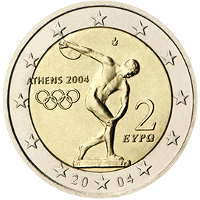 |
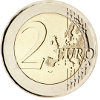 |
C o m m e m o r a t i v e
C o i n s |
||
| Greece | |||||||
The edge lettering on the Greek 2‐Euro‐commemorative coins is : (Hellenic Republic) |
 |
||||||
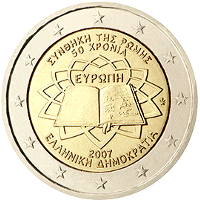 🔎
🔎 |
 |
Greece | 26 Mar. 2007 | 50th anniversary of the Signature of the Treaty of Rome |
20001 20002 20005 |
3,978,549 |  |
National characteristics : At the top are the words "ΣΥΝΘΗΚΗ ΤΗΣ ΡΩΜΗΣ" (Treaty of Rome) and "50 ΧΡΟΝΙΑ" (50 years), below it is an illustration of the treaty with the words "ΕΥΡΩΠΗ" (EUROPE). At the bottom of the motif are the words "ΕΛΛΗΝΙΚΗ ΔΗΜΟΚΡΑΤΙΑ" (Hellenic Republic) above it is the year "2007". On the right is a palmette the mint mark of the Greek mint Νομισματοκοπειο / Nomismatokopeio (Bank of Greece ‐ Mint) in Halandri. |
|||||||
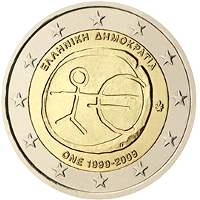 🔎
🔎 |
 |
Greece | 02 Jan. 2009 | 10th anniversary of the Economic and Monetary Union (EMU) |
20001 20002 20005 |
4,000,000 |  |
National characteristics : Above is the name of the issuing country "ΕΛΛΗΝΙΚΗ ΔΗΜΟΚΡΑΤΙΑ" (Hellenic Republic), the acronym of the occasion of issue below is "ΟΝΕ". On the right is a palmette the mint mark of the Greek mint Νομισματοκοπειο / Nomismatokopeio (Bank of Greece ‐ Mint) in Halandri. |
|||||||
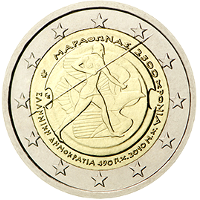 🔎>
🔎> |
 |
Greece | 25 Oct. 2010 | 25th Centenary of the Battle of Marathon |
20001 20002 20005 |
2,500,000 |  |
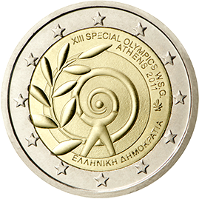 🔎
🔎 |
 |
Greece | 30 May 2011 | XIII. Special Olympics World Summer Games in Athens 2011 |
20001 20002 20005 |
1,000,000 |  |
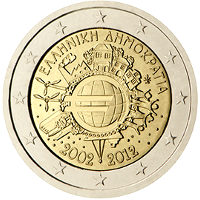 🔎
🔎 |
 |
Greece | 02 Jan. 2012 | 10th anniversary of the Euro‐Currency |
20001 20002 20005 |
1,000,000 |  |
National characteristics : At the top of the coin is the name of the issuing country "ΕΛΛΗΝΙΚΗ ΔΗΜΟΚΡΑΤΙΑ" (Hellenic Republic). To the right, between the symbols of house and the family is a palmette the mint mark of the Greek mint Νομισματοκοπειο / Nomismatokopeio (Bank of Greece ‐ Mint) in Halandri. |
|||||||
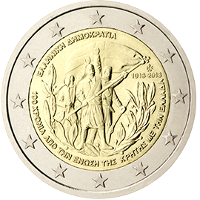 🔎
🔎 |
 |
Greece | 01 Oct. 2013 | 100th anniversary of the union of Crete with Greece |
20001 20002 20005 |
754,000 |  |
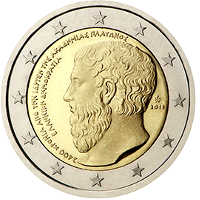 🔎
🔎 |
 |
Greece | 01 Oct. 2013 | 2,400th anniversary of the founding of Plato’s Academy |
20001 20002 20005 |
754,000 |  |
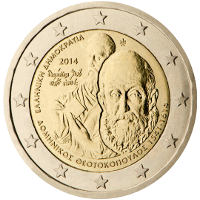 🔎
🔎 |
 |
Greece | 24 Sep. 2014 | 400th anniversary of the death of Dominikos Theotokópoulos |
20001 20002 20005> |
750,000 |  |
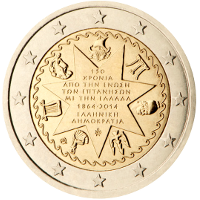 🔎
🔎 |
 |
Greece | 24 Sep. 2014 | 150th anniversary of the Union of the Ionian Islands with Greece |
20001 20002 20005 |
750,000 |  |
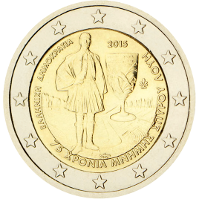 🔎
🔎 |
 |
Greece | 23 Dec. 2015 | 75 years since the death of Spyros Louis |
20001 20002 20005 |
750,000 |  |
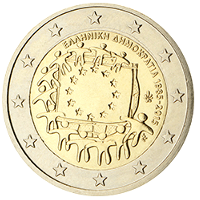 🔎
🔎 |
 |
Greece | 23 Dec. 2015 | 30th anniversary of the EU‐Flag |
20001 20002 20005 |
750,000 |  |
National characteristics : Above is the name of the issuing country "ΕΛΛΗΝΙΚΗ ΔΗΜΟΚΡΑΤΙΑ" (Hellenic Republic), followed by the dates "1985‐2015". On the right is a palmette the mint mark of the Greek mint Νομισματοκοπειο / Nomismatokopeio (Bank of Greece ‐ Mint) in Halandri. |
|||||||
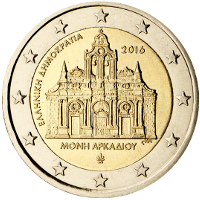 🔎
🔎 |
 |
Greece | 16 Dec. 2016 | 150 years from the Arkadi Monastery Torching |
20001 20002 20005 |
750,000 |  |
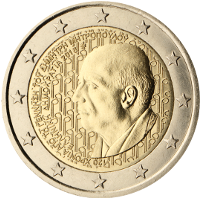 🔎
🔎 |
 |
Greece | 16 Dec. 2016 | 120th birthday of Dimitri Mitropoulos |
20001 20002 20005 |
750,000 |  |
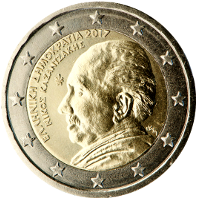 🔎
🔎 |
 |
Greece | 10 Jul. 2017 | 60 years since the death of Nikos Kazantzakis |
20001 20002 |
750,000 |  |
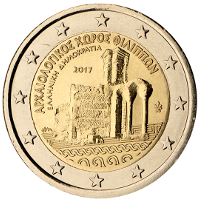 🔎
🔎 |
 |
Greece | 12 Oct. 2017 | Archaeological site of Philippi |
20001 20002 20005 |
750,000 |  |
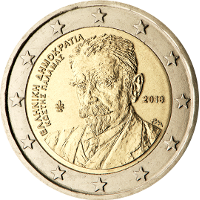 🔎
🔎 |
 |
Greece | 25 Oct. 2018 | 75th anniversary of the death of Kostis Palamas |
20001 20002 20005 |
750,000 |  |
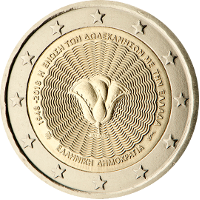 🔎
🔎 |
 |
Greece | 25 Oct. 2018 | 70th anniversary of the union of the Dodecanese with Greece |
20001 20002 20005 |
750,000 |  |
 🔎
🔎 |
 |
Greece | 11 Jul. 2019 | 100th birthday of Manolis Andronikos |
20001 20002 20005 |
750,000 |  |
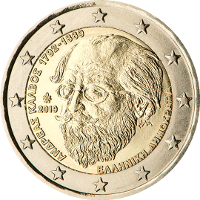 🔎
🔎 |
 |
Greece | 11 Jul. 2019 | 150th anniversary of the death of Andreas Kalvos |
20001 20002 20005 |
750,000 |  |
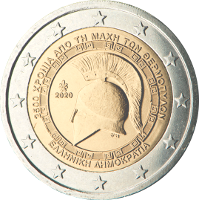 🔎
🔎 |
 |
Greece | 30 Jun. 2020 | 25th Centenary of the Battle of Thermopylae |
20002 20007 20008 |
750,000 |  |
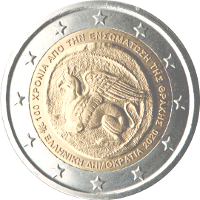 🔎
🔎 |
 |
Greece | 16 Jul. 2020 | 100th anniversary of the union between Thrace and Greece |
20002 20007 20008 |
750,000 |  |
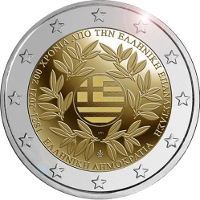 🔎
🔎 |
 |
Greece | 22 Apr. 2021 | 200th anniversary of the Greek Revolution |
20002 20007 20008 |
1,500,000 |  |
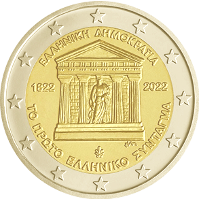 🔎
🔎 |
 |
Greece | 01 Jul. 2022 | 200th anniverasy of the first Greek Constitution |
20003 20005 |
750,000 |  |
 Work in progress |
|||||||
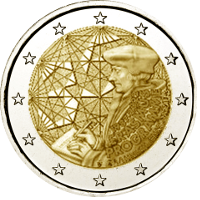 🔎
🔎 |
 |
Greece | 01 Jul. 2022 | 35th anniversary of the Erasmus Program |
20003 20005 20009 |
750,000 |  |
National characteristics : The quarter circle at the bottom right has four lines; below the commemorative period, the issue occasion "ERASMUS PROGRAMME" is written in two lines, below it the issuing country "ΕΛΛΗΝΙΚΗ ΔΗΜΟΚΡΑΤΙΑ" (Hellenic Republic). On the bottom on the left sleeve is a palmette as the mint mark of the Greek mint Νομισματοκοπειο / Nomismatokopeio (Bank of Greece ‐ Mint) in Halandri. |
|||||||
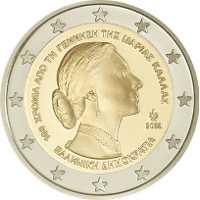 🔎
🔎 |
 |
Greece | 27 Jun. 2023 | 100th birthday of Maria Callas |
20003 20005 20009 |
750,000 |  |
 🔎
🔎 |
 |
Greece | 14 Sep. 2023 | 150th birthday of Constantin Carathéodory |
20003 20005 |
750,000 |  |
 Work in progress |
|||||||
| References : | |||
| 20001 | Images taken with authorisation by the ECB ‐ Mail dated 20.Feb.2020 © "European Central Bank" |
20002 | Data mirrored from Wikipedia Page "2_euro_commemorative_coins" with friendly support of the guardians of that page. |
| 20003 | Images taken with authorisation by H....... Hamburg | 20004 | Coloured version of this Commemorative Coin in circulation EU‐legal‐technical specifications do not recongnise colour prints. The EU nevertheless tolerates them, as their numbers are very small and they are sold in special packs and therefor are very unlikely to be used as currency. |
| 20005 |
enlarged Images taken with authorisation by Gerd Seyffert © "Gerd Seyffert 2021" |
20006 | Not Applicable |
| 20007 | Images taken by Münzen Kreuzberg © "Münzen Kreuzberg 2021" |
20008 | enlarged Images taken by Münzen Kreuzberg © "Münzen Kreuzberg 2021" |
| 20009 | Text with kind permission by Gerd Seyffert © "Gerd Seyffert 2023" |
20010 | Not Applicable |
 |
